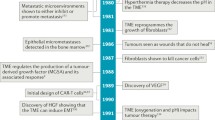Conclusions
An understanding of the nature and significance of tumour capsules may give added perspective to our understanding of the processes of tumour invasion and metastasis. The commonly held concepts of capsule pathogenesis (the expansive growth and foreign body hypotheses) should probably be discarded as they are not supported by experimental evidence. Indeed, our military terminology of tumour ‘invasion’ and host ‘defence’ may be wholly inappropriate in describing the complex interactions that occur between tumour and host, as tumour growth and invasiveness frequently seem to represent a subtle utilization or perversion of normal physiological mechanisms rather than antagonistic interchanges. The value judgements associated with the terms ‘true’ and ‘false’ capsules also give an entirely wrong perspective of the complexities of tumour biology at the tumour-host interface. There is certainly no evidence to suggest that the relationship between capsule formation and benign behaviour is ‘cause and effect’, but rather both are likely to represent parallel manifestations of common underlying tumour-host interactions. The enhancement of tumour encapsulation has been regarded by some as a future therapeutic goal; the key, however, will not lie in the enhancement of fibrogenesis or tumour immunogenicity, but rather in the manipulation of those tumour-host interactions that lead to invasive growth.
Similar content being viewed by others
References
Ashley, D. J. B., 1978,Evan's Histological Appearances of Tumours, 3rd ed. (Edinburgh: Churchill Livingstone).
Baldwin, R. W., andPimm, M. V., 1980, Human tumour xenografts in athymic nude mice: non-specific host rejection responses.Immunodeficient Animals for Cancer Research, edited by S. Sparrow, MRC Laboratory Animals Centre Symposium (London: Medical Research Council).
Barr, L. C., Carter, R. L., andDavies, A. J. S., 1988, The encapsulation of tumours as a modified wound healing response.Lancet, 1988,ii, 135–137.
Berenblum, L., 1970, The nature of tumour growth.General Pathology, edited by H. E. W. Florey, 4th ed. [London: Lloyd-Luke (Medical Books)], pp. 645–667.
Cameron, E., 1982, Vitamin C and cancer: an overview.International Journal of Vitamin and Nutrition Research,23, 115–127.
Cawson, R. A., McCracken, A. W., andMarcus, P. B., 1982,Pathologic Mechanisms and Human Disease (St. Louis: C. V. Mosby), p. 158.
Cohen, I. K., Moncure, C. W., Witorsch, R. J., andDiegelmann, R. F., 1979, Collagen synthesis in capsules surrounding dimethylbenzanthracene induced rat breast tumours and the effect of pretreatment with beta-aminopropionitrile.Cancer Research,39, 2923–2927.
Cohnheim, J., 1889,Lectures on General Pathology, translated by A. B. McKee (New Sydenham Society) (London: Section II).
Dvorak, H. F., 1986, Tumors; wounds that do not heal,New England Journal of Medicine,315, 1650–1659.
Eccles, S. A., 1982, Host immune mechanisms in the control of tumour metastasis.Tumour Immunity in Prognosis, edited by S. Haskill (New York: Marcel Dekker), pp. 37–74.
Enneking, W. F., 1983,Musculoskeletal Tumor Surgery (Edinburgh: Churchill Living-stone), pp. 3–68.
Ewing, J., 1940,Neoplastic Diseases, 4th ed. (Philadelphia: W. B. Saunders).
Foulds, L., 1969,Neoplastic Development, Vol. 1 (London: Academic Press).
Hartveit, F., andHalleraker, B., 1970, Changes in the connective tissue and inflammatory response to Ehrlich's carcinoma following treatment of the host mice with butazolidine.Acta Pathologica et Microbiologica Scandinavica,78, 516–524.
Hunter, J., 1786,Lectures on the Principles of Surgery, published in 1835 asThe Works of John Hunter FRS, edited by J. F. Palmer, Vol. 1 (London: Longman).
Novak, E. R., andWoodruff, J. D., 1974,Novaks Gynecologic and Obstetric Pathology, 7th ed. (Philadelphia: W. B. Saunders), p. 248.
Okuda, K., Hirotaka, M., Nakajima, Y., Kubo, Y., Shimokawa, Y., andNagasaki, Y., 1977, Clinicopathologic features of encapsulated hepatocellular carcinoma.Cancer,40, 1240–1245.
Paillas, J. E., andPellet, W., 1975, Brain metastases.Handbook of Clinical Neurology, edited by P. J. Vinken and G. W. Bruyn (Amsterdam: North-Holland), pp. 201–232.
Ritchie, A. C., 1970, The classification morphology and behaviour of tumours.General Pathology, 4th ed., edited by H. E. W. Florey [London: Lloyd-Luke (Medical Books)], p. 668.
Robbins, S. L., Cotran, R. S., andKumar, V., 1984, Neoplasia.Pathologic Basis of Disease, 3rd ed. (Philadelphia: W. B. Saunders), pp. 214–253.
Shivas, A. A., Bird, C. C., Macdonald, M. K., andLast, J. M., 1980, General pathology of tumours.A Companion to Medical Studies, Vol. 2, 2nd ed., edited by R. Passmore and J. S. Robson (Oxford: Blackwell Scientific).
Strauch, L., 1972, The role of collagenases in tumour invasion.Tissue Interactions in Carcinogenesis, edited by D. Tarin (New York: Academic Press), pp. 399–432.
Author information
Authors and Affiliations
Additional information
This review is based on an MS Thesis research project undertaken at the Chester Beatty Institute for Cancer Research, Fulham Road, London SW3, in collaboration with Professor G. Westbury (Academic Surgical Unit, Royal Marsden Hospital, Fulham Road, London SW3), and Professor A. J. S. Davies and Dr. R. L. Carter (Haddow Laboratories and Royal Marsden Hospital, Downs Road, Sutton, Surrey).
Rights and permissions
About this article
Cite this article
Barr, L.C. The encapsulation of tumours. Clin Exp Metast 7, 277–282 (1989). https://doi.org/10.1007/BF01753680
Received:
Accepted:
Issue Date:
DOI: https://doi.org/10.1007/BF01753680




